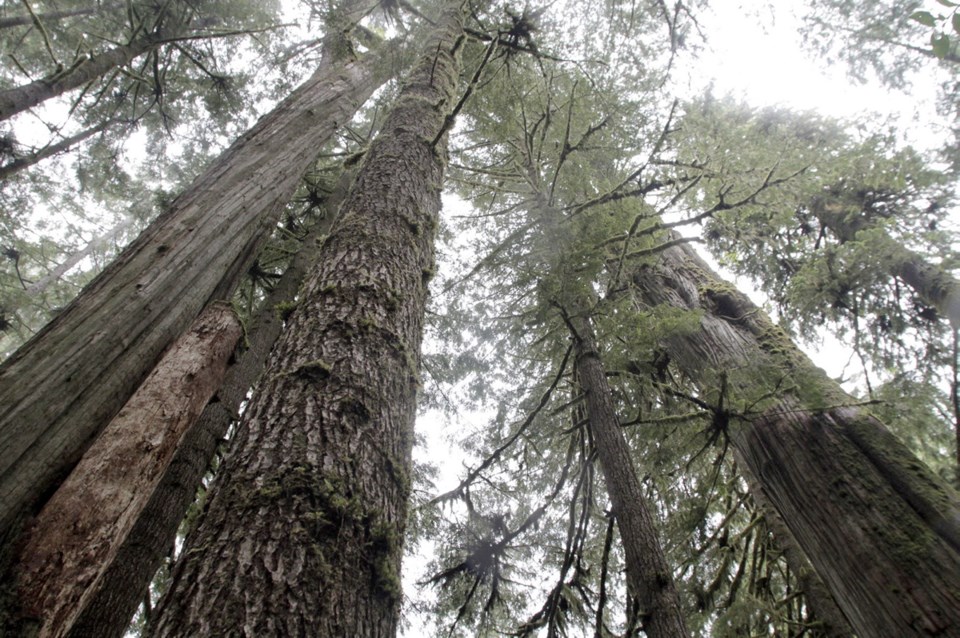Vancouver Island is losing its old-growth forests three times faster than tropical rainforests are disappearing worldwide, according to the Sierra Club of B.C.
The environmental organization said 30 per cent of Vancouver Island’s old-growth forests were logged between 1990 and 2015, based on its own mapping analysis.
Tropical countries saw primary forests decline 10 per cent over the same period, according to the United Nations’ Food and Agriculture Organization.
While the province said the numbers are misleading because reforestation is required by law in B.C., the Sierra Club of B.C. said the value of productive old growth can’t easily be replaced.
The organization and 24 other local and international environmental groups are calling on the next B.C. government to protect productive old-growth stands on Vancouver Island.
“Obviously we are living in a part of the world where we are not faced with economic challenges like many developing countries, so there should be no question remaining about what needs to be done,” said Jens Wieting, forest and climate campaigner for the Sierra Club of B.C.
In order to determine old-growth declines, the Sierra Club of B.C. analyzed forest-cover data and satellite mapping.
Wieting said that an average 9,000 hectares of old-growth forests was logged annually between 2011 and 2015, which equates to about 25 rugby fields per day.
That represents an increase of 12 per cent over the previous four-year period, he said.
About 0.5 per cent of the world’s land is covered by temperate rainforests like those on Vancouver Island, he said, making them a valuable resource globally.
The province called the figures deceptive. B.C. loggers are required by law to reforest areas they harvest, while that’s not the case in many tropical rainforests, said Vivian Thomas, a spokeswoman for the Ministry of Forests, Lands and Natural Resources.
A full old-growth logging ban would have a severe negative impact on local employment, the ministry said.
Of the 55 million hectares of public forest land across the province, 25 million are old-growth and four million are protected or under conservation designations, according to figures from last year that the ministry is updating.
“Old-growth forests in British Columbia are not disappearing,” ministry spokesman Greig Bethel said at the time.
On Vancouver Island, there are about 840,000 hectares of old-growth and over half of that will never be logged, Thomas said.
The Sierra Club of B.C. put the figure lower, saying Island old-growth forests were reduced to 748,000 hectares by 2015.
Wieting said the province’s figures take into account only public land, not private.
He also said it’s important to distinguish productive old-growth forests — which are rich in biodiversity and also attractive to loggers — from old-growth areas that are less ecologically valuable and also less likely to be logged, such as those at high altitudes.
Juan Pablo Castro, a climate scientist and spokesman for Colombian environmental organization Sinfonia Tropico, said his organization supports the protection of Vancouver Island old-growth.
“I support the protection of forests worldwide. They serve not only as carbon sinks and as home to rich biodiversity, but they also protect humans from intense climatic effects,” Castro said.
On April 3, a mudslide that killed more than 300 people in Putumayo, Colombia, was made worse because of deforestation, he said.
In 2016, both the Union of B.C. Municipalities and the B.C. Chamber of Commerce passed resolutions in favour of protecting old-growth forests.
Dan Baxter, spokesman for the B.C. Chamber of Commerce, said in June that members took a balanced approach, recognizing that forestry is a foundation of the economy.
“There are certain situations and communities where old-growth forests are viable, long-term economic generators,” he said.
“At the same time, our members do recognize that we need to have certainty and predictability accessing land, so we have a resolution that also passed that looked at ways to ensure that we don’t unduly impact access to timber harvest lands, either.”
The Huu-ay-aht First Nation opposed the UBCM resolution, saying it interfered with the nation’s rights to manage its lands and territories in accordance with traditional practices.



